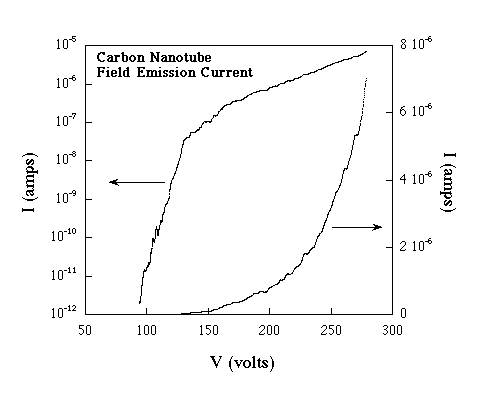Zettl Research Group |
Research Project |
Field Emission from Carbon Nanotubes
Carbon nanotubes have many potential applications. One of these is the use of nanotubes as electron beam sources. A typical nanotube has a diameter of only a few nanometers, but can be microns long. Applying a voltage to such an object causes electrons to be field emitted right off the end of the tube. The effect is due to the intense electric field concentrated at the ultrasharp tip of the nanotube.
We've shown that a viable field emission electron beam source can be be fabricated from carbon nanotubes. The tubes are simply mixed into an epoxy matrix to produce a conducting matrix of tube tips. No matter how the surface is cut, it bristles with the ends of nanotubes, which are typically stronger than any cutting mechanism. Applying a voltage to this epoxy matrix in turn causes these nanotube tips to field emit a stable electron beam.

Thus we have a very simple method of producing an electon beam source. The emitting surface can also be made quite small -- as small as a single pixel on a flat screen display, for example -- and still have many nanotube tips to produce a large current. Large areas can be easily patterned by evaporating a thin layer of gold through a mask. The gold-covered surfaces exhibit no field emission currents. Since this technique is both simple and cheap, the emitting surface can easily be made large, with arbitrary patterning.
For more information, see our published work on nanotube field emission: Applied Physics Letters 69 1969 (1996), and Physical Review B 55 9391 (1997).

 Back to the Zettl Group Page
Back to the Zettl Group Page
